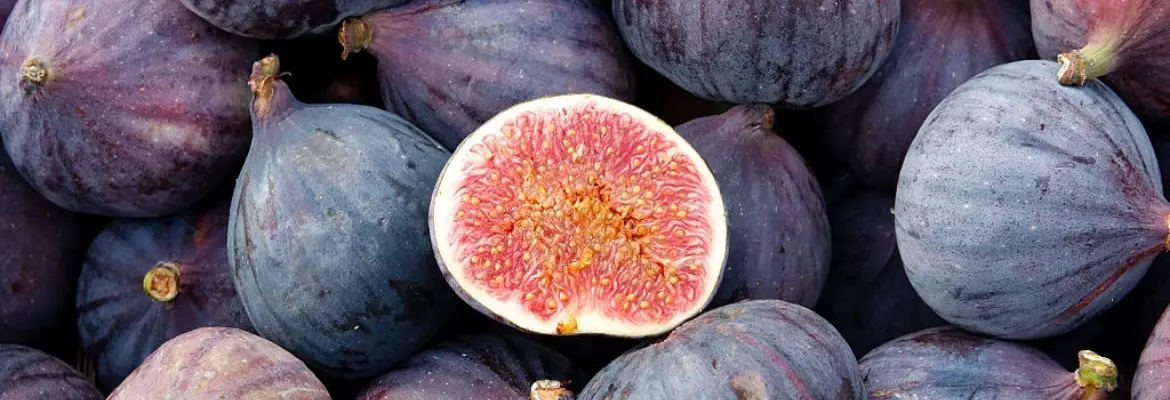Figs have a round, bulbous base that tapers into a narrow neck at the stem end. It has a smooth, taut skin that ranges in color from blue to purple, almost black with faint stripes.
The flesh of the fig can range in color from pink to red to yellow and has a chewy, sticky consistency and many small, crunchy edible seeds. As the fig matures, the skin may crack around the eye or base, causing a small opening exposing the flesh.
Fig’s are typically sweet with a honeyed flavor and have a soft and crisp texture.
Average size of a fig can be around 2 inches (5 cm). Average weight of a fig fruit can be 40 grams (1.4 ounce or 0.08 pounds).

Scientific name of Figs
Ficus Carica
Other names of Figs
- Common Fig
- Higo
- Fico
- Figo
Calories by source in Figs
- Calories by carbohydrate in Figs = 93%
- Calories by fat in Figs = 3%
- Calories by protein in Figs = 4%
Fats and Fatty Acid profile of Figs
- Polyunsaturated fat (PUFA) in Figs = 53%
- Saturated fat (SFA) in Figs = 22%
- Monounsaturated fat (MUFA) in Figs = 25%
Nutrition facts of Figs
*Serving size = 100 grams = 3.55 Ounces = 1/2 cup
*DV= % Daily Value (%DV indicates how much nutrients contribute to a person’s daily diet from a serving of a food. DV assists you in determining whether or not a serving of food is high or low in a particular nutrient.)
| Nutrient | Amount | Unit | DV |
|---|---|---|---|
| Calories | 74 | KCAL | |
| Fat | 0.3 | GRAM | 0% |
| Protein | 0.75 | GRAM | 2% |
| Carbohydrate | 19.18 | GRAM | 7% |
Detailed vitamin profile of Figs, vitamin A, vitamin B12, vitamin B6, vitamin C, vitamin D, Folate, Niacin, Thiamin, and Riboflavin is shown in the chart.
Detailed mineral profile of Figs, Sodium(Na), Calcium(Ca), Copper(Cu), Iron(Fe), Magnesium(Mg), Selenium(Se), Phosphorus(P), Potassium(K) and Zinc(Zn) is shown the chart.
Check freshness in Figs
- Fresh figs are firm and plump to the touch
- Little bit of tearing is okay in figs
- The hole at the bottom of a fresh fig is moist (A little bit of liquid oozing out)
- Figs stop ripening process as soon as they are harvested from the tree
- When gently pressed, fresh fig gives in just a little bit
- Old figs will feel mushy
- Avoid figs with a sour smell ( fig has started fermenting)
- Old figs will start shrinking and loose their typical shape unlike well rounded shape of a fresh fig
Availability of Figs
- The Seasons of Figs depend on the geographical location where it is being cultivated
- Dried figs are available round the year
- India – Figs season ranges from May – June
- Japan – Figs season ranges from August – October
- Italy – Figs season ranges from August – September
- USA – Figs season ranges from June and August – October
How to store Figs
- Fresh figs will spoil in a week from harvesting day
- At room temperature figs can be stored for 2-3 days
- Fresh figs can be stored in refrigerator for almost a week
- Figs can also be stored in the freezer for 6-7 months
- Place the figs on a tray and freeze them. After freezing, transfer the figs in freezer bag or container and store in the freezer
Complete nutrition facts of Figs
Click on the link HERE to download high quality, high resolution and print ready PDF version of the Figs nutrition chart/infographic.


